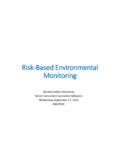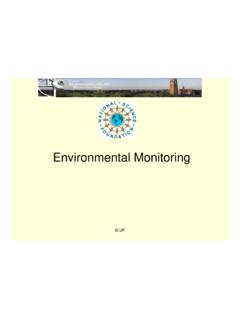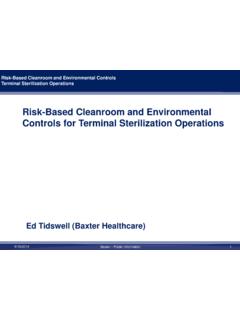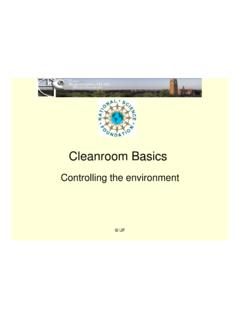Transcription of Environmental Monitoring - Cleanroom Consulting
1 MManufacturingpharmaceutical andbiotechnologyproducts requiresthat the appropriatelevel of quality be designed andconstructed into the facility andsystems that support theproduction process. As a result ofrecent 483 observations and warningletters, the FDA s current compliancefocus is on inadequate facility designand Environmental and personnelmonitoring. One can only concludethat the skill level, training, andattitude of the personnel involved inthe cases cited were inadequate withrespect to the obvious requirementto minimize particulate, microbial,and pyrogen sample of FDA observations onenvironmental Monitoring violationsculled from warning letters availableto the public on the FDA websiteincludes the following: Monitoring is not conductedroutinely nor concurrently withmanufacturing.
2 Sampling shouldbe done daily during both shifts,both inside and outside of the LAF(laminar air flow) areas, and sampletimes should be varied to cover allparts of the production period. Sampling frequencies andlocations must be defined. Microbial air samples underlaminar flow modules are collectedonly under static conditions. Less than 10% of themicrobial air samples were collectedafter noon, although productionroutinely continues until 3:00 PM room air microbial samples arecollected with the RCS (rotarycentrifugal sampler) on a tripod at aheight of five feet, which does notrepresent working level in theserooms. There is no trending of data. There has been no dailymonitoring of aseptic areas and LAFmodules for nonviable particulateson a day of production basis.
3 HEPA filters have beencertified with DOP (di-octylphthalate) and a particle counterand not with a photometer. Air velocities have beenreported as average and do notshow the individual readings. HEPA filters need to be DOPtested at least twice a year, not oncea year as is currently being done. Some of the validations of airquality in rooms were done onlyunder static conditions withoutpersonnel. Also no smoke patternstudies on the LAF have beenperformed to show effects of curtainmovements on laminar air flows. The firm has not set alert andaction limits for most environmentalsamples .. firm needs to identifyall organisms isolated from asepticarea until a database is establishedfor normal flora found in theproduction environment (withfrequency distribution) for use inevaluating sterility test results.
4 Fail to eliminate objectionableorganisms from interior surfaces oftransfer carts in which sterilizedunsealed containers of drug productare exposed. No validation studies havebeen conducted to assure themicrobial settle plates are capable ofsupporting microbial growth afterPRODUCT:ALL REGULATED PRODUCTSPROCESSFOCUS:MANUFACTURINGWHOSHO ULDREAD:PROJECTMANAGERS,MANUFACTURING, QA/QC,REGULATORY AFFAIRSKEYWORDS:ENVIRONMENTALMONITORING, clean room ,CONTAMINATION CONTROL,VIABLE,NONVIABLE,PARTICULATE,MIC ROBIOLOGICALLEVEL:INTERMEDIATEBIOPROCESS TECHNICAL2 BioProcess InternationalFEBRUARY2004 DIGITALVISION( ) Environmental MonitoringParticle Counts Are EasyScott E. Macklerthe stated three-hour exposure timein Class 100 rooms. Class 10,000 areas have aviable limit of CFU (colonyforming units).
5 The quality control unit didnot assure that adequate systemsand controls were in place tomonitor the functioning of, and todetect malfunctions of, the airhandling systems used to controland assure aseptic conditions inaseptic manufacturing areas. How do those types of situationsdevelop? Whereas from time to timethe European Union may providesome specific recommendations formeeting cGMPs, the FDA normallydoes not dictate how a specificoutcome is to be achieved. A classic example comes to mindwhen considering the number ofunidirectional flow aseptic fillcleanrooms that, once built, haveproven unable to meet validationrequirements. In most of thosesituations, the aseptic fill applicationwas treated as if it were simply aClass 100 particle countrequirement without regard for thecritically important airflow patternsrequired to ensure that exposedproducts and components areprotected from processing operations mustbe performed within separate,defined areas to prevent microbialand/or cross ANDSURVEILLANCEN onviable particulate and viablemicrobiological surveillance are usedto evaluate the design and controlof a cGMP-manufacturingenvironment.
6 The nonviableparticulate Monitoring program isused to verify the maintenance of airclassifications called for in a facilitydesign. Particulate monitoringshould be performed routinelyusing statistical sampling proceduresthat are appropriate for eachindividual room , piece ofequipment, and process. In general, a comprehensiveenvironmental Monitoring programshould include scheduledmonitoring of airborne viable andnonviable particulates; pressuredifferentials; direction of air flow;temperature and humidity; andsurface microbial contaminants onpersonnel and equipment, worktables, floors, and walls. Somecompanies are beginning to monitorchemical contamination (airbornemolecular contamination involving,for example, sulfuric oxides, nitrousoxides, ozone, and volatile organiccompounds) and site-specificcontaminants (such as chlorine,organophosphates, and ammonia)when and where such concerns designed, controlled,and maintained HVAC systems,along with appropriate facilitymonitoring systems, are crucial fordemonstrating and maintainingcontrol.
7 Facility monitors mustrapidly detect and record any changethat might lead to a compromisedenvironment, and the monitoringsystem must alert personnel of suchchanges nonviables should bemonitored and controlled in allcritical and controlled Monitoring should befrequent, and in aseptic areas thepersonnel should be routinelymonitored as well. Typical microbialflora should be identified and theresulting records input into ahistorical database for trend and action levels are developedbased on the resulting trends andproduct protection procedures forinvestigating contamination eventsmust be developed. Allowable airborne viable countsvary with air classification and amongthe different regulatory agencies. Anenvironmental Monitoring programshould include routine testing ofcritical process support servicesincluding clean , dry compressed air;gases; and process water (RO/DI,USP water, and WFI).
8 Air and surfaces in critical areasshould be monitored for particulatequality daily during all productionshifts because shedding by personnelis typically the primary source ofcontamination. Table 1 lists airborneviable limits compared with variousair (nonviable) classification levels. Itis not meant to imply any relationshipbetween these two metrics, however,FEBRUARY2004 BioProcess International3 TTaabbllee 11::Comparing airborne viable limits among various nonviable air classification levelsISO 8 ISO 7 ISO 5 Authority(Class 100,000)(Class 10,000)(Class 100)FDA CDER June 1987 aseptic25<1processing guidelines cfu/10 ft3 Draft USP <1116>, February 1997< < < Microbiology cfu/ft3(cfu/m3)(<100)(<20)(<3)EC Annex 1, 1997 cfu/m3(cfu/10 ft3)10010<1(30)(3)( )TTaabbllee 22::Comparing ISO 14644 with FS-209E.
9 Equivalence is almost exact at m butdiffers somewhat at other particle concentration limits (particles/m3air) for particlesClassificationequal to and larger than the considered sizes shown m m m m m m209 EClass 1102 Class 210024104 Class 310002371023581 Class 410,000237010203528310 Class 5100,00023,70010,200352083229100 Class 61,000,000237,000102,00035,2008320293100 0 Class 7352,00083,200293010,000 Class 83,520,000832,00029,3001,000,000 Class 935,200,000 8,320,000 293,000because generally no good correlationcan be made between airborneparticulates and 29 November 2001, the USGeneral Services Administration(GSA) officially announced thatFederal Standard 209E (FS-209E), Airborne Particulate CleanlinessClasses in Cleanrooms and CleanZones, had been canceled and isnow superseded by the ISOstandards for cleanrooms andassociated controlled environments:ISO14644-1, Classification of AirCleanliness, and ISO 14644-2, Specifications for Testing andMonitoring to Prove ContinuedCompliance with ISO 14644-1.
10 The GSA action resulted from arecommendation made by IESTW orking Group CC-100 to sunset Federal Standard 209E infavor of the ISO documents. FS-209E was a very useful standardthat defined the minimumacceptable criteria for USgovernment contracts acrossvirtually all industries. It hadbecome widely accepted for use inprivate contracting as well andserved as the de facto key referenceto consult when quantifying theparticulate cleanliness of a cleanspace. The ISO documents areequally useful and should serve topromote global industrialharmonization for cleanroomcleanliness classification. Table 2 compares the class designations have changedfrom FS-209E to ISO with an obvious change tothe metric measures for air volume,ISO 14644-1 adds three additionalclasses: two cleaner than Class 1 andone dirtier than Class 100, also forces the contractualpartners to specify the particle sizeof interest and the state ofcleanroom occupancy forcertification.









